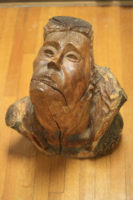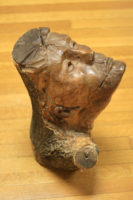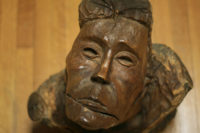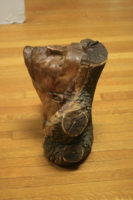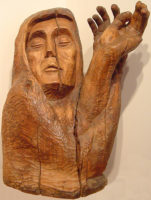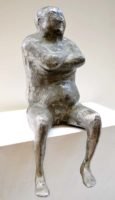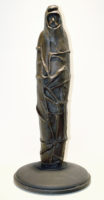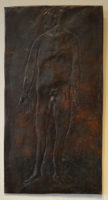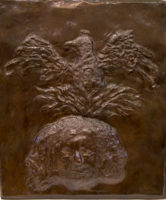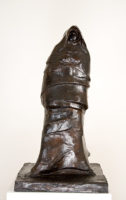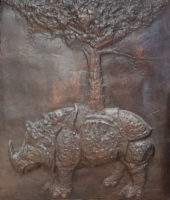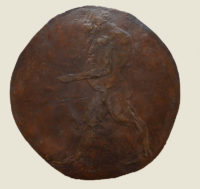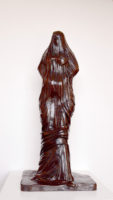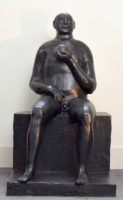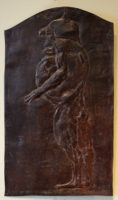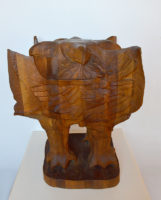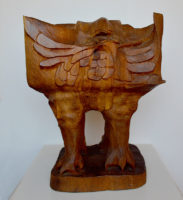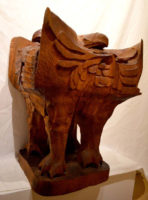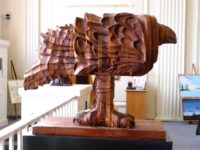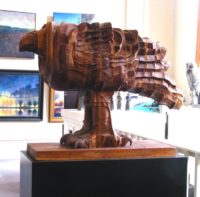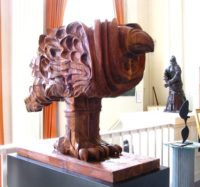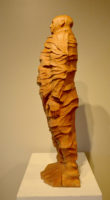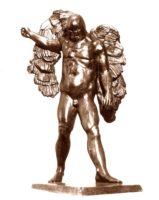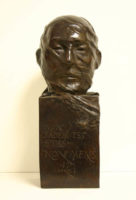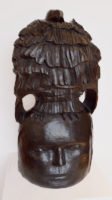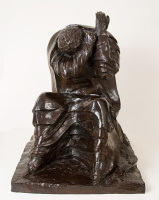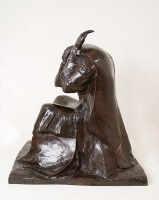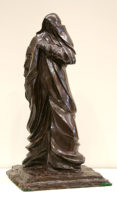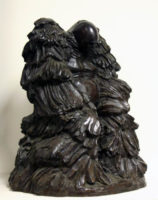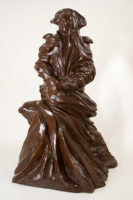Leonard Baskin: Leonard Baskin, Sculptor: A Retrospective
Very early in his nearly six-decade career, Baskin came to the conclusion that sculpture was the medium best suited to expressing fundamental human states such as grief, love, hope, and dignity. Its very monumentality makes it an art of witness and resistance to oppression. Baskin’s relentless pursuit of his themes has been so encompassing that to call a work in any of the mediums he mastered “Baskin-like” conveys an unsentimental confrontation with mortality and the political forces of the time. His vision is often a dark one, but it is the brilliance of our fight, our survival against the odds, our attempts at communication and understanding, that constitute the glory of humanity and exist, always, at the core of Baskin’s art.
1940s
The 1940s were a formative decade for Baskin. He had finished his apprenticeship with Maurice Glickman in 1939, and moved through a number of schools – NYU, Yale, and the New School for Social Research – as well as serving in the U.S. Navy during WWII. He was deeply influenced by Marxist ideas and the struggles against capitalism and racism. His early woodcuts were rife with proletarian workers and vicious capitalist eagles.
Pelle the Conqueror depicts the eponymous protagonist of Martin Anderson Nexø’s great proletarian novel from Denmark, a work that Baskin found profoundly moving. In the midst of his fascination with Communist ideas, Baskin is also attracted to Pelle’s individualism, chafing at the confines of the ideology he is simultaneously embracing.
Pelle holds the seeds of what would become his mature style, and hints at the iconography he would later explore.
The themes of death, grief and suffering also appear in Baskin’s work almost from the beginning. His post-WWII carving Mourning Mother was perhaps his first serious work grappling with the subject. While the romantic depiction of death is a common subject for young artists, Baskin, steeped in images of Dachau and Buchenwald, understood early on the trauma of war and the horrors of the Twentieth Century.
Pelle the Conqueror
18 in
Front View
18 in
Right Side View
18 in
Top View
18 in
Left Side View
Mourning Mother
25×21 in
25×21 in
1950s
At the very end of the 1940s Baskin spent a year studying in Paris and Florence. While there, he was deeply affected by Egyptian and Mesopotamian sculpture, works that deepened his understanding of monumentality. He was also attracted to the life-size medieval gisants, great sculpted stone effigies glorifying the kings and archbishops entombed below. Baskin responded to these with a series of Dead Men, his principal sculptural project of the 1950s. Baskin’s gisants, however, were not the mighty and the powerful, but the unknown common souls, the unnoticed and unremembered dead. They do not lie, pristine, in a mythological afterlife but are truly, corporeally, dead. They strike out at the tyranny of the emperors and the aristocracy that tramples over all in search of immortality. But Baskin’s dead also strike out at the oppression of death itself. As he said, “Art is man’s distinctly human way of fighting death. Art is an action against death. It is denial of death.”
13.5x6x10 in
31x17x16 in
22.25x10x10 in
21×11 in
1960s
The 1960’s saw Baskin entrench himself as an embattled warrior against the prevailing abstraction and avant-gardism gripping the art world: “Art is content,” he insisted, “or it is nothing.”
He began to explore the cloaked and mantled subject. While wrapped figures had occasionally appeared in the 1950s, in such sculptures as Lazarus and John Donne in his Winding Cloth, Baskin now uses the wrapping as an expressive device, often enveloping his subjects in mourning or grief. Female figures also start to appear, with such subjects as Phaedra and Andromache demonstrating his mastery of this modality at the end of the decade.
Also starting to appear in greater numbers were Baskin’s raptors and crows. The raptors, along with their kin the birdmen, are never benign; some are austere or foreboding, while others are forcefully malevolent, the embodiment of oppression. The crows, however, are more ambiguous figures – scavengers and outcasts, surviving by their wits, on occasion forced to prey on those weaker than themselves, they are the most human of Baskin’s birds.
19×16.5 in
32x16x20 in
19.5×40 in
19.5×16 in
17.5×17.25 in
1970s
A deep and abiding concern with the plight of the marginalized and the oppressed was present from the earliest days of Baskin’s career; starting in the late 60s, this concern found a new focus. A 1968 commission from the National Park Service to create drawings for a new guidebook to Little Bighorn Battlefield National Monument led to a large body of work depicting Native American figures. Rebelling against the Hollywood distortions and the cliches of popular culture, and informed by a new historical understanding, he captured the sense of loss and betrayal as well as the strength and intensity of such nineteenth century indigenous leaders as Crazy Horse, Geronimo, and Quannah Parker.
In 1974 Baskin gave up his faculty position at Smith College and moved with his family to England, buying a house in a small village in Devon close to his friend, the poet Ted Hughes. Freed from the yoke of teaching, he continued to explore his favored themes with growing intensity, producing sculpture of ever-increasing ambition, such as his monumental wood carving The Altar, now at the Jewish Museum in New York. At the end of the decade, he faced a medical crisis – a pituitary tumor that necessitated an extended hospitalization and surgery; his 1980 Wrapped Self Portrait memorializes that event.
38×16.5×13 in
45x27x29 in
24.25×14.25 in
Idolatry
24×14.5×14 in
24×14.5×14 in
24×14.5×14 in
1980s
In 1983 Baskin moved back to America, settling into an old farmhouse in Leeds and taking a teaching position at Hampshire College. He continued working in wood and bronze, exploring subjects of long-standing interest in such works as Yoked Crow and Ceremental Figure. He also introduced new subjects that would go on to recur frequently in his work; these included the sibyls, female oracles from Ancient Greece, and his representations of death as a figure not emaciated and starved, but rather glutted and gorged from the slaughters and depredations of the Twentieth Century.
Yoked Crow
38x19x42 in
38x19x42 in
38x19x42 in
Ceremental Figure
35.25x13x9 in
35.25x13x9 in
35.25x13x9 in
31x19x11 in
42x16x17.5 in
19x7x7 in
35×16.5×15 in
1990s
The 1990s brought opportunities for Baskin to show his vision on a larger scale with two major commissions, the Ann Arbor Holocaust Memorial and the Franklin Delano Roosevelt Presidential Memorial in Washington D.C. Each of them depicts grief, but they do so in entirely different ways – the Roosevelt Memorial captures the mourning of a nation, while the Holocaust Memorial is a solitary figure, turned inwards in anger and sorrow.
Baskin was diagnosed with myeloma in early 1999; he continued working in his studio until the days before his death, in the early summer of 2000.
The Franklin Delano Roosevelt Presidential Memorial
On May 2nd, 1997, President Bill Clinton dedicated the Franklin Delano Roosevelt Memorial in the nation’s capital. Designed by Lawrence Halprin, it incorporates granite, water, sculptures and carved inscriptions to convey the experience of Roosevelt’s four terms in office.
Baskin was chosen as one of the memorial’s sculptors in 1978; planning for the work stalled, and then was revived, and the memorial was finally completed in 1995. Baskin’s thirty-foot long bas-relief of Roosevelt’s funeral cortege, installed above a still pool in a deep alcove, is the most contemplative part of the memorial, a profound representation of the grief of a nation.

Ann Arbor Holocaust Memorial
On the site of the first Jewish cemetery in Michigan stands the Ann Arbor Holocaust Memorial, installed in 1994, a seven-foot seated figure entirely enveloped in itself, its garments obscuring its form, a fist over its face and a hand raised to the sky. Baskin described the figure as “ambivalent … in some sort of misery, wrapped up entirely in himself.” While the fist “portrays deep and powerful anger,” the open hand is “far more felicitous, raised possibly in mercy, forgiveness, tenderness, gentleness, all of those qualities.”
27x20x24 in
27x20x24 in
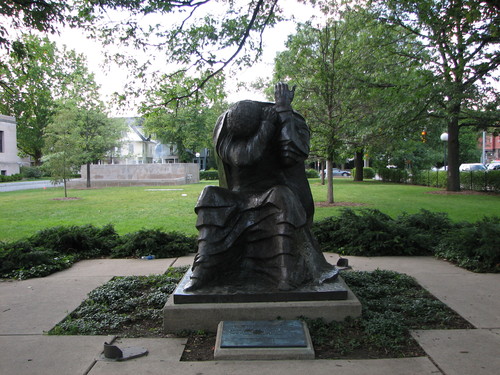
29x22x22 in
20x15x15 in
35x21x25 in

